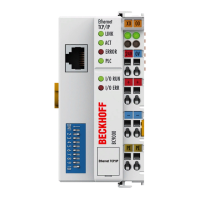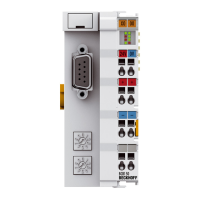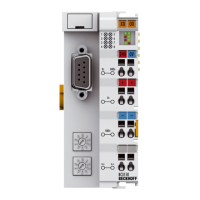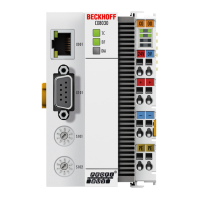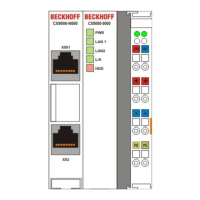Product overview
BC9000 and BC9100 11Version: 4.0.0
Technical data BC9000 BC9100
Number of Bus Terminals 64
Digital peripheral signals 256 inputs/outputs
Analog peripheral signals 128 inputs/outputs
Protocols Beckhoff ADS, ModbusTCP
Configuration possibility via the KS2000 configuration software or the controller (TwinCAT)
Maximum number of bytes 512bytes I and 512bytes O
Bus connection 1 x RJ 45 2 x RJ45
Internal switch - 3-port switch (two external connections)
Power supply 24V
DC
(-15%/+20%)
Input current 70mA + (total K-bus current)/4
Starting current approx. 2.5 x continuous current
Recommended fuse ≤10A
K-Bus power supply up to 1750mA
Power contact voltage max. 24V
DC
Power contact current load 10A max.
Dielectric strength 500V (power contact/supply voltage/fieldbus)
Weight approx. 170g
Operating temperature -25°C ... +60°C
Storage temperature -40°C...+85°C
Relative humidity 95% no condensation
Vibration/shock resistance conforms to IEC 68-2-6 / IEC 68-2-27
EMC immunity/emission conforms to EN 50082 (ESD, burst) / EN 50081
Mounting position variable
Protection class IP20
2.4 Technical Data for the PLC
PLC data BC9000 BC9100
Programmability via programming interface (TwinCAT) or via Ethernet (TwinCAT)
Program memory 64/96kbyte
Data memory 64/128kbyte
Remanent flags 4kbyte
PLC cycle time Approx. 1.5ms for 1000 IL commands
(without I/O cycle)
Approx. 1.2ms for 1000 IL commands
(without I/O cycle)
Programming languages IEC 6-1131-3 (IL, LD, FBD, ST, SFC)
2.5 Ethernet
Ethernet was originally developed by DEC, Intel and XEROX (as the "DIX" standard) for passing data
between office devices. The term nowadays generally refers to the IEEE802.3 CSMA/CD specification,
published in 1985. Because of the high acceptance around the world this technology is available everywhere
and is very economical. This means that it is easy to make connections to existing networks.
There are now a number of quite different transmission media: coaxial cable (10Base5), optical fiber
(10BaseF) or twisted pairs (10BaseT) with screen (STP) or without screen (UTP). Using Ethernet, different
topologies can be built such as ring, line or star.
Ethernet transmits Ethernet packets from a sender to one or more receivers. This transmission takes place
without acknowledgement, and without the repetition of lost packets. To achieve reliable data
communication, there are protocols, such as TCP/IP, that can run on top of Ethernet.

